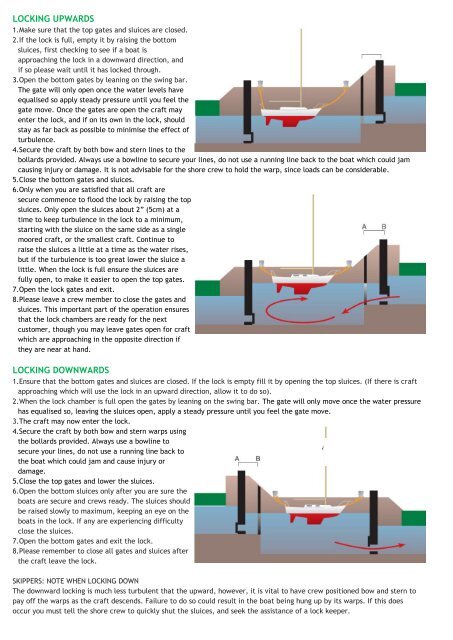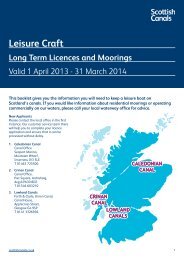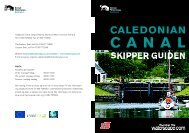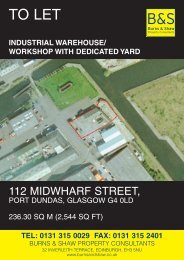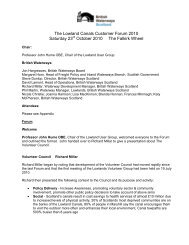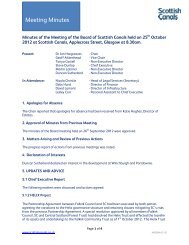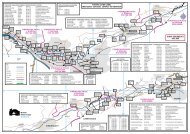Crinan Canal Skippers Guide - Scottish Canals
Crinan Canal Skippers Guide - Scottish Canals
Crinan Canal Skippers Guide - Scottish Canals
Create successful ePaper yourself
Turn your PDF publications into a flip-book with our unique Google optimized e-Paper software.
LOCKING UPWARDS<br />
1.Make sure that the top gates and sluices are closed.<br />
2.If the lock is full, empty it by raising the bottom<br />
sluices, first checking to see if a boat is<br />
approaching the lock in a downward direction, and<br />
if so please wait until it has locked through.<br />
3.Open the bottom gates by leaning on the swing bar.<br />
The gate will only open once the water levels have<br />
equalised so apply steady pressure until you feel the<br />
gate move. Once the gates are open the craft may<br />
enter the lock, and if on its own in the lock, should<br />
stay as far back as possible to minimise the effect of<br />
turbulence.<br />
4.Secure the craft by both bow and stern lines to the<br />
bollards provided. Always use a bowline to secure your lines, do not use a running line back to the boat which could jam<br />
causing injury or damage. It is not advisable for the shore crew to hold the warp, since loads can be considerable.<br />
5.Close the bottom gates and sluices.<br />
6.Only when you are satisfied that all craft are<br />
secure commence to flood the lock by raising the top<br />
sluices. Only open the sluices about 2” (5cm) at a<br />
time to keep turbulence in the lock to a minimum,<br />
starting with the sluice on the same side as a single<br />
moored craft, or the smallest craft. Continue to<br />
raise the sluices a little at a time as the water rises,<br />
but if the turbulence is too great lower the sluice a<br />
little. When the lock is full ensure the sluices are<br />
fully open, to make it easier to open the top gates.<br />
7.Open the lock gates and exit.<br />
8.Please leave a crew member to close the gates and<br />
sluices. This important part of the operation ensures<br />
that the lock chambers are ready for the next<br />
customer, though you may leave gates open for craft<br />
which are approaching in the opposite direction if<br />
they are near at hand.<br />
LOCKING DOWNWARDS<br />
1.Ensure that the bottom gates and sluices are closed. If the lock is empty fill it by opening the top sluices. (If there is craft<br />
approaching which will use the lock in an upward direction, allow it to do so).<br />
2.When the lock chamber is full open the gates by leaning on the swing bar. The gate will only move once the water pressure<br />
has equalised so, leaving the sluices open, apply a steady pressure until you feel the gate move.<br />
3.The craft may now enter the lock.<br />
4.Secure the craft by both bow and stern warps using<br />
the bollards provided. Always use a bowline to<br />
secure your lines, do not use a running line back to<br />
the boat which could jam and cause injury or<br />
damage.<br />
5.Close the top gates and lower the sluices.<br />
6.Open the bottom sluices only after you are sure the<br />
boats are secure and crews ready. The sluices should<br />
be raised slowly to maximum, keeping an eye on the<br />
boats in the lock. If any are experiencing difficulty<br />
close the sluices.<br />
7.Open the bottom gates and exit the lock.<br />
8.Please remember to close all gates and sluices after<br />
the craft leave the lock.<br />
SKIPPERS: NOTE WHEN LOCKING DOWN<br />
The downward locking is much less turbulent that the upward, however, it is vital to have crew positioned bow and stern to<br />
pay off the warps as the craft descends. Failure to do so could result in the boat being hung up by its warps. If this does<br />
occur you must tell the shore crew to quickly shut the sluices, and seek the assistance of a lock keeper.


